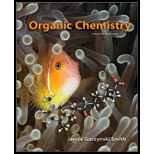
Concept explainers
For each of the following substituted benzenes: [1]
a. Does the substituent donate or withdraw electron density by an inductive effect?
b. Does the substituent donate or withdraw electron density by a resonance effect?
c. On balance, does the substituent make a benzene ring more or less electron rich than benzene itself?
d. Does the substituent activate or deactivate the benzene ring in electrophilic
Want to see the full answer?
Check out a sample textbook solution
Chapter 18 Solutions
Organic Chemistry - With Access (Looseleaf) (Custom)
- Stanozolol is an anabolic steroid that promotes muscle growth. Although stanozolol has been used by athletes and body builders, many physical and psychological problems result from prolonged use and it is banned in competitive sports. a.Explain why the nitrogen heterocycle—a pyrazole ring—is aromatic. b.In what type of orbital is the lone pair on each N atom contained? c. Draw all reasonable resonance structures for stanozolol. d.Explain why the pKa of the N—H bond in the pyrazole ring is comparable to the pKa of the O—H bond, making it considerably more acidic than amines such as CH3NH2 (pKa = 40).arrow_forwardRank the following groups in order of decreasing priority. −CH=CH2, −CH3, −C≡CH, −Harrow_forwardThe shrub ma huang (Section 5.4A) contains two biologically active stereoisomers—ephedrine and pseudoephedrine—with two stereogenic centers as shown in the given structure. Ephedrine is one component of a once-popular combination drug used by body builders to increase energy and alertness, whereas pseudoephedrine is a nasal decongestant. a.Draw the structure of naturally occurring (−)-ephedrine, which has the 1R,2S configuration. b.Draw the structure of naturally occurring (+)-pseudoephedrine, which has the 1S,2S configuration. c.How are ephedrine and pseudoephedrine related? d.Draw all other stereoisomers of (−)-ephedrine and (+)pseudoephedrine, and give the R,S designation for all stereogenic centers. e.How is each compound drawn in part (d) related to (−)-ephedrine?arrow_forward
- A hydrocarbon of unknown structure has the formula C8H10. On catalytichydrogenation over the Lindlar catalyst, 1 equivalent of H2 is absorbed. Onhydrogenation over a palladium catalyst, 3 equivalents of H2 are absorbed.(a) How rnany degrees of unsaturation are present in the unknown?(b) How many triple bonds are present?(c) How many double bonds are present?(d) How many rings ar e present?(e) Draw a structure that fits the data.arrow_forwardDraw resonance contributors for the following species and rank them in order of decreasing contribution to the resonance hybrid. Then draw the resonance hybrid. CH3C-CH3-CH=CHCH3arrow_forwardRank the following groups in order of decreasing priority. a. – COOH, – H, – NH2, – OH b. – H, – CH3, – Cl, – CH2CI c. -CH2CH3, -CH3, -H, -CH(CH3)2 d. – CH = CH2, – CH3, – C ≡ CH, – Harrow_forward
- For the following compounds, which pairs of hydrogens (Ha and Hb) are enantiotopic hydrogens? b. Which pairs are diastereotopic hydrogens?arrow_forwardConsider the four trienes E–H. Rank compounds E–H in order of increasing heat of hydrogenation.arrow_forwardRank the following groups in order of decreasing priority. a.−F, −NH2, −CH3, −OH b.−CH3, −CH2CH3, −CH2CH2CH3, −(CH2)3CH3 c.−NH2, −CH2NH2, −CH3, −CH2NHCH3 d.−COOH, −CH2OH, −H, −CHO e.−Cl, −CH3, −SH, −OH f.−C≡CH, −CH(CH3)2, −CH2CH3, −CH=CH2arrow_forward
- Order the following substituents from highest priority to lowest priority: CH3, OH, H,F. Use the Cahn-Ingold-Prelog priority system. a. F, CH3, OH, H b. H, CH3, F, OH c. F, OH, CH3, H d. H, CH3, OH, Farrow_forward(a) Draw a three-dimensional line structure of (5R,6Z)-6,7-dichloro-5-hydroxynon-6-enal. Place the aldehyde group on the right-hand side of your drawing.(b) Give the Cahn-Ingold-Prelog priority order of the four groups (-OH, -H, -(CH2)3CHO, -C4H5Cl2) at the C5 stereocentre (Highest 1 > 2 > 3 > 4 Lowest).arrow_forwardFor the given ee values, calculate the percentage of each enantiomer present.a. 90% eeb. 99% eec. 60% eearrow_forward
 Organic Chemistry: A Guided InquiryChemistryISBN:9780618974122Author:Andrei StraumanisPublisher:Cengage Learning
Organic Chemistry: A Guided InquiryChemistryISBN:9780618974122Author:Andrei StraumanisPublisher:Cengage Learning

